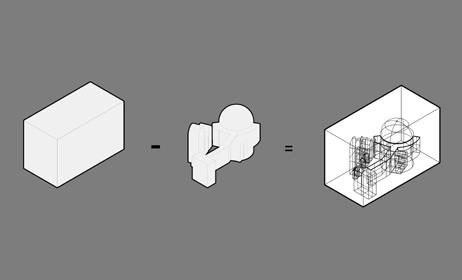
2 minute read
Architecture As Objects Invoking Emotions
Vijul Shah
Using the idea of how Architecture invokes emotions in its interpreter’s mind, three different strategies were explored using formal autonomy.
Indifference: A wall is a familiar object, used to join the floor and the ceiling. But what if it doesn not do that? The form explores an idea when a wall is used as a space creating mechanism. It willingly detaches from the floor and the ceiling, creating multiple planes of spatial geometries. These geometries can tehn be explored to create internal as well as external spaces. The form exerts an emotion of a weird, random object.
Estrangement: A wall is used to enclose spaces. But what if the wall is stacked together to create un-enclosed spaces? The form tries to use a Wall as a compositional elements, collecting and deforming it to create un-familiarity. The overall composition made of walls completely eludes from its original meaning and interpretation, and invokes an emotion of strangness.
Ambivalence: A wall is usually solid, having straight edges. But what if it expands and becomes something else. The form is ambivalent to a regular and an abstract geometry. It translates into dumb, a-frontal form as it moves from one end to other.
Parti diagram

PROJECT # 3 PERFORMING ARTS HERE?
“One thing is certain: architecture will become ever more itself while at the same time becoming everything other than what architecture is today. The discipline of architecture is ramifying. There are, and will be, many architectures – alas, not of equal value. Some will be short-lived; some will persist longer. We are witnessing the demise of the belief in singular, dominating ideologies, as well as a loss of confidence in the teleology of technological improvement.” Jesse Reiser & Nanako Umemoto
The primary task of architecture is to articulate and define space for activities to occur. Within this paradigm the timing seems right to question our relationships to current and future environments, as well as to each other. This studio argues that architecture is in need of a discourse that foregrounds reorientation more so than a singular graphic or formal exercise. This is not to say shape and aesthetics are not important, but there is too much at stake for architecture to not be thinking about techniques and strategies that might reorient architecture and it’s users to the assumptions that facilitated the contemporary condition, a condition confronted by the immanent threats of a post-truth political landscape, climate change, wealth inequality, and systemic racial injustice. In this Project, students explored the freedom(s) that might come from architecture’s reorientation, freedoms where architectural pursuits are fuzzy and diverse, indifferent and ambivalent, estranged and unfamiliar. The Arts Commons Transformation (ACT) will serve as a medium for synthesizing your critical reading of the city and architecture’s ability to produce new worlds through its formal production, towards a reorientation of our perspectives, lifestyles and goals, to better tackle the pressures ahead. This is no small feat and responses will likely need to challenge existing modes of formal (re)production and aesthetic representation. With this in mind, students were given the freedom to develop a response on their own terms, so long as the work strives to question our starting points and reorient ourselves towards a multiplicity of possible futures.


Hidden mechanisms in design










